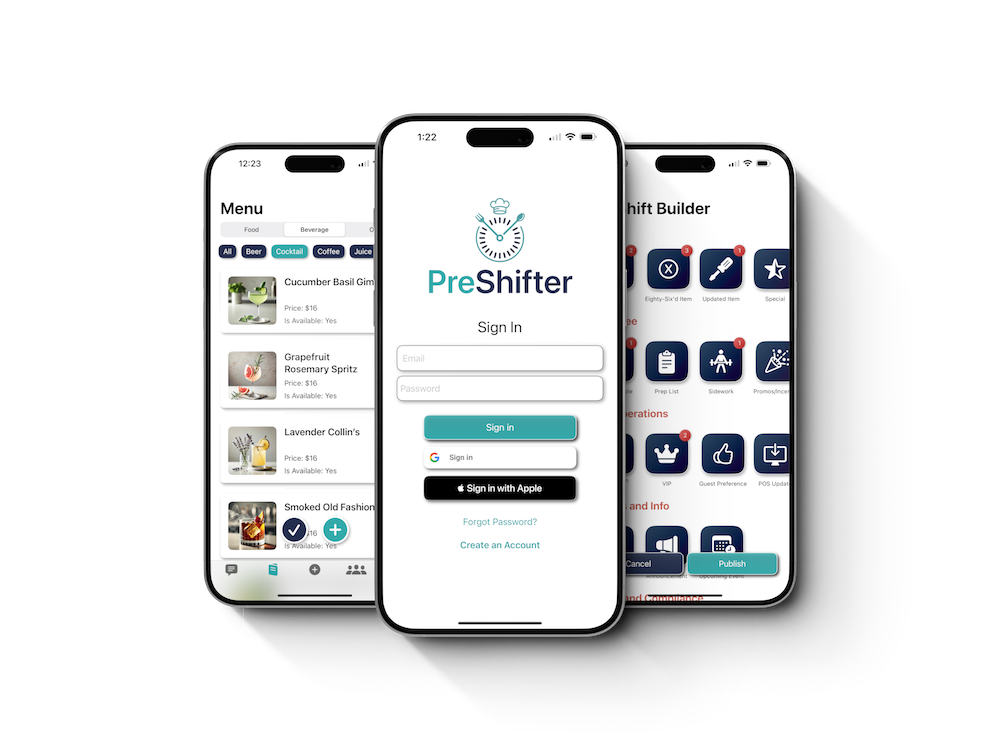It’s 4:00ish PM. Your staff is arriving like extras from a zombie film, dragging their feet, eyes glazed from last night’s closing shift, and slugging back cold-brew when really it’s hair-of-the-dog they need. You shout out a new special like you’re throwing a life preserver to drowning passengers: “Tonight’s special is, uh, salmon… something?” Heads nod vacantly, but inside, panic alarms blare louder than the ticket printer at peak dinner rush.
If this feels uncomfortably familiar, you’re not alone. This is life in hospitality. And let’s be honest: it’s a pretty miserable way to run a shift.
I’ve been there. After two decades navigating New York City’s restaurant chaos (think Michelin stars meets existential despair), I realized most disasters don’t explode mid-service—they quietly fester in those rushed, chaotic moments right before the doors open.
Here’s the good news: you’re probably making the same mistakes as everyone else. The bad news? They’re silently sabotaging your service, your sanity, and your bottom line.
Let’s expose these culprits, laugh (maybe cry) a bit at our shared pain, and fix them, hopefully for good.
1. Starting Service Without a Clear Pre-Shift Briefing
Some managers treat pre-shifts like parsley garnishes—pointless, quickly discarded, and existing only because someone said they should (don’t garnish with parsley). I’ve watched eyes roll, yawns suppressed, and felt the subtle energy drain as yet another manager skipped the pre-shift meeting almost entirely, thinking they were saving precious time. Spoiler alert: they weren’t.
Here’s the psychological twist: skipping pre-shifts feels efficient, but it’s actually costing you big time. It breeds confusion, creates a weird game of restaurant telephone, and leaves your staff wandering the floor anxious and aimless. Table turns slow to a crawl, servers second-guess their every move, and guests sense the subtle chaos like bloodhounds sniffing out fear.
But here’s the secret: a focused, structured pre-shift takes less time than your barista spends making a latte. I’m talking five minutes, tops. Just enough to align everyone’s mindset, communicate critical updates clearly, and lay down expectations. Those three little minutes? They save you hours of damage control, comped dishes, awkward apologies, and yes—existential dread.
Invest in clarity upfront. Your guests, your team, and your sanity will thank you.
2. Dumping Too Much Info at the Last Minute
You know that scene in every action movie, where the hero frantically diffuses a bomb with two seconds left, sweat dripping, hands shaking? That’s exactly how your staff feels when you bombard them with a tsunami of last-minute updates: menu changes, specials, 86s, table assignments, side-work, all delivered at lightspeed, seconds before doors open.
Here’s the darkly funny part: managers dump info like this out of sheer panic, terrified they’ll forget something crucial. Ironically, this panic-induced info dump virtually guarantees that your team forgets almost everything. They’re overwhelmed, anxious, and caught in mental freeze – like deer trapped in headlights, if deer wore aprons and needed to upsell appetizers.
The psychological truth is simple: human brains crave clarity, not chaos. So, stop shouting menu updates like a Wall Street trader on blow. Instead, break information into calm, digestible bites and push it out through a structured, digital platform. Let your team absorb key info on their own terms, in their own space, at their own pace.
Less shouting, more clarity. Watch your service smooth out faster than a perfectly chilled Negroni.

3. Neglecting Visual and Written Cues for New Menu Items
You know that dream… you’re standing tableside, confidently describing tonight’s special, but suddenly realize you have absolutely no idea what it is? Cue awkward pause, guest skepticism, and internal screaming. Unfortunately, for your servers, this nightmare is often reality.
Managers love to play a twisted game of memory roulette, rattling off new dishes verbally once (usually with half the ingredients mispronounced) and expecting servers to flawlessly sell them. Spoiler alert: it never ends well. Under the stress of service, your servers’ brains retain about as much verbal menu info as a colander holds water.
The fallout? Clumsy explanations, confused guests, missed upsells, and dishes comped because “this wasn’t what I ordered.” Profits leak away quietly – death by a thousand comped plates.
The fix is painfully obvious (yet often ignored): give your team something to see. Human brains adore visual anchors – clear images and concise, written cues are instantly memorable. “Seeing is remembering.” When your servers have immediate, visual access to dish descriptions, plating, and allergens, they confidently describe, upsell effortlessly, and dodge awkward guest interrogations.
Swap memory roulette for visual clarity, and watch sales rise while comps vanish—just like that recurring server nightmare.
4. Using Informal Communication Channels (Group Chats & Texts)
Ah, the dreaded restaurant group chat – every manager’s favorite chaotic dumpster fire. Sure, WhatsApp and text groups feel easy. Quick message here, emoji reaction there. Feels like convenience, right? But let’s be brutally honest: It’s the communication equivalent of scribbling shift notes on napkins and hoping they won’t accidentally get tossed out.
Think of group texts as the wild west of updates: critical information buried beneath memes, shift swaps tangled in reaction GIFs, and important announcements drowned out by someone’s weekend drama. It’s not just messy – it’s operational anarchy.
What’s the real-world impact? Missed shifts, ignored specials, total confusion, and an accountability black hole so deep, you’d need NASA to investigate it. Everyone sees the messages, sure – but nobody truly owns them. Cue: finger-pointing, irritated guests, and managers frantically scrolling through chats mid-service like forensic investigators hunting for clues.
Here’s the reality check: Your staff doesn’t need another meme – they need clarity. Centralize your communication into a single, trusted, organized platform. No clutter, no chaos, just total clarity. One place where everyone goes for answers. One source of truth.
“Eliminate ambiguity entirely.” Your sanity (and your team’s group-chat-fatigued eyes) will thank you.
5. Not Clarifying Roles & Assignments Clearly
You know that moment… staff frozen mid-floor, exchanging confused looks like they’re auditioning for a restaurant-themed sitcom titled Whose Station Is It Anyway? Managers often assume their team “knows the drill,” believing assignments are intuitive or obvious. But this blind trust can lead to restaurant Darwinism: survival of the loudest and fastest, with quieter or newer staff wandering aimlessly like lost puppies.
The fallout is predictable but painful: duplicated efforts, empty tables ignored, or worse – guests watching as multiple servers descend upon them simultaneously in an awkward, overenthusiastic swarm. Efficiency tanks, stress peaks, and service suffers silently.
The solution is embarrassingly simple (but often neglected): clearly assign and document everyone’s roles and stations before service begins. Make assignments visible, obvious, and impossible to misunderstand. The magic of crystal-clear expectations? Everyone relaxes. Everyone owns their job. Everyone stays accountable.
Clarity isn’t just kindness; it’s an operational necessity.
6. Ignoring the Power of Positive Tone-Setting
Ever walked into a restaurant and immediately sensed a vibe colder than yesterday’s leftover seafood special? Chances are, a manager unknowingly set that tone. Managers underestimate their own mood, dismissing their attitude as inconsequential. Spoiler: it’s not. Negativity spreads faster than gossip in a break room. And if leadership seems irritated, stressed, or indifferent, your staff amplifies it tenfold.
The subtle yet crushing result? Servers go into survival mode, bartenders disengage, hosts avoid eye contact. The team’s energy dives, service gets robotic, and guests feel less like welcome diners and more like inconveniences interrupting a collective argument.
But the opposite holds true, too. A single intentional moment of positivity – a brief joke, sincere encouragement, clear enthusiasm – can ignite a spark. Teams mirror their leaders, absorbing and reflecting whatever energy is set from the top. One uplifting moment, carefully timed at the start of a shift, transforms employees into engaged, energized brand ambassadors.
Set the tone intentionally. Your guests, your team’s mental health, and your bottom line depend on it.
7. Assuming Staff Read Updates
Managers treat sending out shift updates like planting messages in bottles and tossing them into the ocean – hoping desperately they’ll wash up on the shores of awareness. Spoiler alert: they usually don’t. Just because you’ve told your staff something doesn’t mean they’ve absorbed it. Human brains (especially stressed restaurant brains) aren’t inboxes—they’re sieves.
Here’s a dark truth every restaurant vet knows intimately: “I didn’t see the message” is restaurant code for “your update got lost somewhere between the group chat memes and my existential dread.” Result? Servers blind-sided by guests mentioning specials they’ve never heard of, awkward table-side improvisations, frantic managers comping meals, and spiraling frustration for everyone involved.
The answer isn’t repeating yourself louder (though we all try it). Instead, implement tools that require confirmation – staff checking off updates as seen. Confirmations close the loop, eliminate ambiguity, and keep everyone accountable. No more message-in-a-bottle; just direct, measurable clarity.

8. Managers “Winging It”
We all know that one manager – the fearless improviser, the charismatic rogue. “Preparation? That’s adorable,” they scoff, sipping an espresso while casually rewriting floor plans on a napkin five minutes before service. While charmingly chaotic at first glance, this arrogance slowly poisons consistency and professionalism, leaving your team confused and wary.
“Managers winging it” might make a great reality TV show, but in the trenches of service, it’s a disaster. Shifts feel unpredictable, team trust evaporates, and servers anxiously await the manager’s latest whim like extras in a badly-directed play. This lack of structure isn’t edgy – it’s reckless.
The boring truth? Structure works. It stabilizes service, boosts team confidence, and delivers consistent guest experiences. Provide managers with structured templates and a clear routine. Leadership consistency isn’t just professional – it’s sanity-saving. Your entire operation calms, shifts flow smoothly, and trust returns.
“Leadership consistency stabilizes your entire operation.” Save improv for theater night, not the dinner rush.
9. Not Prioritizing Specials & Promotions
Picture this: your chef creates an inspired, high-margin special – an exquisite dish crafted to excite diners and boost your bottom line. You proudly announce it once, mumbling through ingredients as distracted servers tie aprons and check their phones. You figure, “Eh, they’ll remember it.” Spoiler: they won’t.
Managers constantly underestimate the connection between emphasizing specials and actual sales. Staff won’t push dishes they barely remember, let alone dishes they feel uncertain describing. The result? Servers defaulting to the safe, boring classics—missing valuable upselling opportunities, lower check averages, and lost potential revenue drifting silently out the door.
Here’s the harsh but simple truth: “What you emphasize, your team sells.” Treat your specials like star performers, not forgettable side-characters. Make your reminders clear, concise, and memorable. Provide visual aids, tasting notes, and quick talking points.
Consistent emphasis transforms specials from forgotten menu ornaments into revenue-driving heroes. Your bank account (and your chef’s ego) will thank you.
10. Not Soliciting Employee Feedback
Managers love pushing information downward, envisioning themselves as wise captains steering the ship solo. But the harsh reality? Ignoring staff feedback is like throwing away a winning lottery ticket because you’re too stubborn to check the numbers.
Front-line employees – servers, bartenders, hosts – hold insights that managers simply can’t see from the sidelines. They hear guest whispers, experience menu confusion firsthand, and spot tiny operational cracks before they become service catastrophes. Yet managers often keep communication painfully one-way, treating staff as passive receivers rather than active contributors.
This top-down approach breeds disconnected teams, low morale, and missed opportunities for real improvements. Employees feel undervalued and disengage, while managers scratch their heads, wondering why shifts feel lackluster and disjointed.
Flip the script. Create simple, consistent ways for your employees to offer insights during pre-shifts. Tap into their collective wisdom regularly. Your staff isn’t just labor – they’re a hidden goldmine of knowledge and improvement waiting to be discovered.
Trust them. Listen to them. Your restaurant will reap the benefits.

Conclusion
Here’s the uncomfortable truth we all know deep down but rarely admit: most restaurant chaos isn’t some random cosmic punishment – it’s entirely self-inflicted. Each mistake we’ve walked through might seem minor alone, but together they’re quietly bleeding your bottom line, sabotaging your team’s morale, and killing your sanity one shift at a time.
The good news? You can fix every one of these problems today – without extra stress, shouting louder, or pretending that frantic is your new normal.
You don’t need a miracle. You need structure, clarity, and a system built by someone who’s spent enough late nights in the trenches to truly understand the pain. (Spoiler alert: that’s me.) PreShifter is that system. A simple, digital toolkit specifically designed to cut through your daily chaos and replace it with crystal-clear communication, accountability, and calm.
And if you’re the skeptical type (like every seasoned restaurant vet), try us free for 14 days – no strings attached.
Chaos might always be waiting around the corner, but how you handle it is entirely your call.
Your team deserves better. Your guests deserve better. And let’s be honest – you deserve better too.





